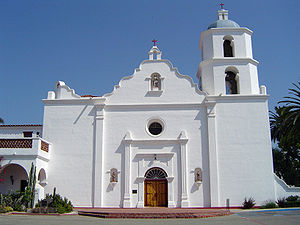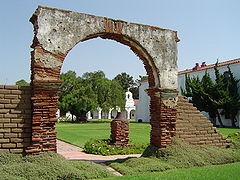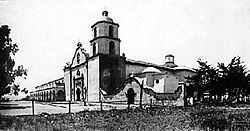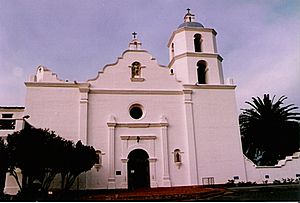- Mission San Luis Rey de Francia
-
- For the novel by Thornton Wilder, see "The Bridge of San Luis Rey".
Mission San Luis Rey de Francia 
Today, Mission San Luis Rey de Francia is well maintained. This Mission is architecturally distinctive due to the combination of Spanish Renaissance, Moorish—Mudéjar, and Spanish Colonial architecture styles.Location 4050 Mission Ave.
Oceanside, California 92057Name as founded La Misión de San Luis, Rey de Francia [1] English translation The Mission of Saint Louis, King of France Patron Louis IX of France [2] Nickname(s) "King of the Missions" [3] Founding date June 13, 1798 [4] Founding priest(s) Father Fermín Lasuén [5] Founding Order Eighteenth [2] Military district First (El Presidio Reál de San Diego) [6] Native tribe(s)
Spanish name(s)Kumeyaay, Quechnajuichom
Luiseño & Diegueño 'Mission Indians'Native place name(s) Quechinga—Quechla [7][8] Baptisms 5,399 [9] Marriages 1,335 [9] Burials 2,718 [9] Neophyte population 2,788 [10][11] Secularized 1834 [2] Returned to the Church 1865 [2] Governing body Roman Catholic Diocese of San Diego Current use Parish/Museum/Cemetery/Retreat House Coordinates 33°13′57.2082″N 117°19′12.6336″W / 33.232557833°N 117.320176°W National Historic Landmark #NPS–70000142 Date added to the NRHP 1970 California Historical Landmark #239 Website http://www.sanluisrey.org/ Mission San Luis Rey de Francia, also known as Mission San Luis Rey or San Luis Rey Mission Church, was founded on June 13, 1798 in coastal Las Californias, in the present day U.S. city of Oceanside in California. The local Quechnajuichom Native American tribe became known as the Luiseño 'Mission Indians', after the Mission's 'Luis'. The current church, built in 1811 is the third church on this location.[12] It is a National Historic Landmark, for its pristine example of a Spanish Mission Church complex.[13]
Contents
Spanish era
The original name, La Misión de San Luis, Rey de Francia (The Mission of Saint Louis, King of France) was named for King Louis IX of France.[1][2] It's 'nickname' was "King of the Missions"[3] It was founded by padre Fermín Lasuén on June 13, 1798, the eighteenth of the twenty-one Spanish missions in California built in the upper Las Californias Province of the Viceroyalty of Nueva España[2][4][5] At its prime the Mission San Luis Rey's structures and services compound covered almost 6 acres (24,000 m2), making it one of the largest of the missions, along with its agricultural land grant property beyond.[14]
In 1816, the Mission San Antonio de Pala Estancia Asistencia ("sub-mission") was established 20 mi (32 km) inland. In 1823 the Las Flores Asistencia
An early account of life at the Mission was written by one of its Native American converts, Luiseño Pablo Tac, in his work Indian Life and Customs at Mission San Luis Rey: A Record of California Mission Life by Pablo Tac, An Indian Neophyte (written circa 1835 in Rome, later edited and translated in 1958 by Minna Hewes and Gordon Hewes). In his book, Tac lamented the rapid population decline of the Luiseño, of his people: On June 13, 1798 the mission was found or built:
In Quechla not long ago there were 5,000 souls, with all their neighboring lands. Through a sickness that came to California 2,000 souls died, and 3,000 were left.[8]
The Mission-born, Franciscan-educated Tac noted that his people initially attempted to bar the Spaniards from invading their Southern California lands.
When the foreigners approached, "...the chief stood up...and met them," demanding, "...what are you looking for? Leave our Country!"
Pablo Tac went on to describe the preferential conditions and treatment the padres received:
In the mission of San Luis Rey de Francia the Fernandiño [sic] father is like a king. He has his pages, alcaldes, majordomos, musicians, soldiers, gardens, ranchos, livestock....[15]
Mexican and early American eras
The first Peruvian Pepper Tree (Schinus molle) in California was planted here in 1830, now iconic, widely planted, and renamed the 'California Pepper tree' in the state. During the Mexican-American War in Alta California (1846–1847), the Mission was utilized as a military outpost by the United States Army.[14]
In July 1847, U.S. military governor of California Richard Barnes Mason created an Indian sub-agency at Mission San Luis Rey, and his men took charge of the mission property in August, appointing Jesse Hunter from the recently arrived Mormon Battalion as sub-agent. Battalion guide Jean Baptiste Charbonneau, the Native American Shoshone child of Sacagawea who had traveled with the Lewis and Clark Expedition forty years earlier, was appointed by Mason as the Alcalde "within the District of San Diego, at or near San Luis Rey" in November 1847. Charbonneau resigned from the post in August, 1848, claiming that "because of his Indian heritage others thought him biased when problems arose between the Indians and the other inhabitants of the district."[16]
Secularization to present
With secularization of the mission in 1834, no religious services were held and the Luiseño were left behind by the fleeing Franciscan padres. The Mission's religious services restarted in 1893, when two Mexican priests were given permission to restore the Mission as a Franciscan college.[14] Father Joseph O'Keefe was assigned as an interpreter for the monks. It was he who began to restore the old Mission in 1895. The cuadrángulo (quadrangle) and church were completed in 1905. San Luis Rey College was opened as a seminary in 1950, but closed in 1969.
The first season's episodes of the Zorro TV series were filmed here in 1957. Walt Disney added a skull and crossbones to the cemetery entrance. In 1998, Sir Gilbert Levine led members of the Los Angeles Philharmonic and, with the special permission of His Holiness Pope John Paul II, the ancient Cappella Giulia Choir of St. Peter's Basilica, in a series of concerts to commemorate the 200th Anniversary of the founding of the mission. These festival concerts constituted the first-ever visit of this 500 year-old choir to the Western Hemisphere. The concerts were broadcast on NPR’s “Performance Today”.
 The courtyard of Mission San Luis Rey de Francia, with the first Peruvian Pepper Tree (Schinus molle) planted in California in 1830, visible behind the arch.[14]
The courtyard of Mission San Luis Rey de Francia, with the first Peruvian Pepper Tree (Schinus molle) planted in California in 1830, visible behind the arch.[14]
Today, Mission San Luis Rey de Francia is a working mission, cared for by the people who belong to the parish, with ongoing restoration projects. Mission San Luis Rey has a Museum, Visitors Center, gardens with the historic Pepper Tree, and the original small Cemetery.[17]
Mission San Luis Rey Mission San Luis Rey de Francia, circa 1910.
Mission San Luis Rey de Francia, circa 1910.Nearest city: Oceanside, California Coordinates: 33°13′57″N 117°19′10″W / 33.2325°N 117.31944°WCoordinates: 33°13′57″N 117°19′10″W / 33.2325°N 117.31944°W Built: 1811 Architectural style: Spanish Colonial architecture Governing body: Private NRHP Reference#: 70000142[18] Significant dates Added to NRHP: April 15, 1970 Designated NHL: April 15, 1970[19] Mission industries
The Native Americans in California, with their over estimated 8,000 years of residency and being self-sufficient in the bountiful environs, knew how to cultivate and harvest the flora and fauna for food and clothing, and utilized stone, wood, clay, bone, hides, reeds and grasses, and seashells for making tools, garments, sophisticated baskets and pottery, weapons, ceremonial religious items, and in building shelters and community structures.
The goals of the missions were, above all, to establish a Spanish presence in the Las Californias province and to become independently self-supportive (by their standards and perceived needs). Ranching and farming were the most important industry of the mission. To have the indigenous residents using foreign skills, training in agriculture for European crops, blacksmithing, and domestic animal husbandry was given. The Luiseños were relocated and conscripted to do the herding, farming, construction, hide tanning and leatherwork, weaving, cooking, and cleaning. Everything consumed and utilized by the Spanish and Luiseño living at the mission was predominantly produced there by those native people under the control of padres and soldiers. Imports, by sea and overland, from central New Spain (Mexico) added with some trade goods and the Crown's modest supplemental funds.
Mission bells
Bells were vitally important to daily life patterns at the mission. The bells were rung: to call residents for work, mealtimes, and religious services, during birth and funeral ceremonies, to signal the approach of a ship or returning Spaniard, and for other occasional needs. Novices and Luiseños were instructed in the traditional rituals for ringing the mission's bells in its large architectural Bell tower.
See also
- Las Flores Asistencia
- Mission San Antonio de Pala
- Luiseño—Mission Indians
- Population of Native California
- California mission clash of cultures
- USNS Mission San Luis Rey (AO-128) — a Buenaventura Class fleet oiler launched during World War II.
References
 Mission San Luis Rey de Francia as it appeared in 1986. In 1841, French explorer Eugene Duflot de Mofras produced a sketch of the Mission that depicted a second campanario, thereby supporting the theory that two bell towers were planned, but never completed; the lone tower was also used as a lookout post.[20]
Mission San Luis Rey de Francia as it appeared in 1986. In 1841, French explorer Eugene Duflot de Mofras produced a sketch of the Mission that depicted a second campanario, thereby supporting the theory that two bell towers were planned, but never completed; the lone tower was also used as a lookout post.[20]
- Engelhardt, Zephyrin, O.F.M. (1920). San Diego Mission. James H. Barry Company, San Francisco, CA.
- Engelhardt, Zephyrin, O.F.M. (1922). San Juan Capistrano Mission. Standard Printing Co., Los Angeles, CA.
- Forbes, Alexander (1839). California: A History of Upper and Lower California. Smith, Elder and Co., Cornhill, London.
- Johnson, John; Crawford, Dinah; O'Neil, Stephen (1998). "The Ethnohistoric Basis for Cultural Affiliation in the Camp Pendleton Marine Base Area: Contributions to Luiseno and Juaneno Ethnohistory Based on Mission Register Research."
- Jones, Terry L. and Kathryn A. Klar (eds.) (2007). California Prehistory: Colonization, Culture, and Complexity. Altimira Press, Landham, MD. ISBN 0-759-10872-2.
- Krell, Dorothy (ed.) (1979). The California Missions: A Pictorial History. Sunset Publishing Corporation, Menlo Park, CA. ISBN 0-376-05172-8.
- Leffingwell, Randy (2005). California Missions and Presidios: The History & Beauty of the Spanish Missions. Voyageur Press, Inc., Stillwater, MN. ISBN 0-89658-492-5.
- Lightfoot, Kent G. (2004). Indians, Missionaries, and Merchants: The Legacy of Colonial Encounters on the California Frontiers. University of California Press, Berkeley, CA. ISBN 0-52020-824-2.
- Paddison, Joshua (ed.) (1999). A World Transformed: Firsthand Accounts of California Before the Gold Rush. Heyday Books, Berkeley, CA. ISBN 1-890771-13-9.
- Ruscin, Terry (1999). Mission Memoirs. Sunbelt Publications, San Diego, CA. ISBN 0-932653-30-8.
- Yenne, Bill (2004). The Missions of California. Thunder Bay Press, San Diego, CA. ISBN 1-59223-319-8.
- Young, Stanley and Melba Levick (1988). The Missions of California. Chronicle Books LLC, San Francisco, CA. ISBN 0-8118-3694-0.
- ^ a b Leffingwell, p. 27
- ^ a b c d e f Krell, p. 273
- ^ a b Yenne, p. 158
- ^ a b Yenne, p. 156
- ^ a b Ruscin, p. 196
- ^ Forbes, p. 202<refits a pretty mission>Engelhardt, San Diego Mission, pp. v, 228 "The military district of San Diego embraced the Missions of San Diego, San Luis Rey, San Juan Capistrano, and San Gabriel."
- ^ Ruscin, p. 195
- ^ a b Lightfoot, p. 108
- ^ a b c Krell, p. 315: as of December 31, 1832; information adapted from Engelhardt's Missions and Missionaries of California.
- ^ Krell, p. 315: as of December 31, 1832; information adapted from Engelhardt's Missions and Missionaries of California. Mission San Luis Rey was by far the most dominant of the Alta California missions at this time in terms of the number of neophytes attached to it.
- ^ Johnson, et al.: "In contrast to baptismal patterns documented at missions in much of the rest of California, Mission San Luis Rey appears to have coexisted with nearby native communities for a much longer period of time without fully absorbing their populations...This may be the result of a conscious decision by the head missionary at Mission San Luis Rey, Fr. Antonio Peyri, to permit a certain number of baptized Luiseños to remain living apart from the mission with their unconverted relatives at their rancherías [villages]. The native communities in this way gradually became converted into mission ranchos at Santa Margarita, Las Flores, Las Pulgas, San Jacinto, Temecula, Pala, etc."
- ^ NHL Details
- ^ NHL Writeup[dead link]
- ^ a b c d Young, p. 18
- ^ Lightfoot, p. 105
- ^ Reading, Mrs. James. "Jean Baptiste Charbonneau: The Wind River Scout". The Journal of San Diego History, April 1965, Volume 11, Number 2.
- ^ http://www.sanluisrey.org/ Mission San Luis Rey website
- ^ "National Register Information System". National Register of Historic Places. National Park Service. 2008-04-15. http://nrhp.focus.nps.gov/natreg/docs/All_Data.html.
- ^ List of NHLs in California
- ^ Krell, pp. 275-276
External links
- Official Mission San Luis Rey website
- Calisphere—California Digital Library: Early photographs, sketches, and land surveys of Mission San Luis Rey de Francia.
- Elevation & Site Layout sketches of the Mission compound
- Satellite image from Google Maps
- Early History of the California Coast, a National Park Service Discover Our Shared Heritage Travel Itinerary
California missions San Diego de Alcalá (1769) · San Carlos Borromeo de Carmelo (1770) · San Antonio de Padua (1771) · San Gabriel Arcángel (1771) · San Luis Obispo de Tolosa (1772) · San Francisco de Asís (1776) · San Juan Capistrano (1776) · Santa Clara de Asís (1777) · San Buenaventura (1782) · Santa Barbara (1786) · La Purísima Concepción (1787) · Santa Cruz (1791) · Nuestra Señora de la Soledad (1791) · San José (1797) · San Juan Bautista (1797) · San Miguel Arcángel (1797) · San Fernando Rey de España (1797) · San Luis Rey de Francia (1798) · Santa Inés (1804) · San Rafael Arcángel (1817) · San Francisco Solano (1823)
Asistencias
Nuestra Señora Reina de los Angeles (1784) · San Pedro y San Pablo (1786) · Santa Margarita de Cortona (1787) · San Antonio de Pala (1816) · Santa Ysabel (1818)Estancias
San Bernardino de Sena (1819) · Santa Ana (1820) · Las Flores (1823)U.S. National Register of Historic Places Topics Lists by states Alabama • Alaska • Arizona • Arkansas • California • Colorado • Connecticut • Delaware • Florida • Georgia • Hawaii • Idaho • Illinois • Indiana • Iowa • Kansas • Kentucky • Louisiana • Maine • Maryland • Massachusetts • Michigan • Minnesota • Mississippi • Missouri • Montana • Nebraska • Nevada • New Hampshire • New Jersey • New Mexico • New York • North Carolina • North Dakota • Ohio • Oklahoma • Oregon • Pennsylvania • Rhode Island • South Carolina • South Dakota • Tennessee • Texas • Utah • Vermont • Virginia • Washington • West Virginia • Wisconsin • WyomingLists by territories Lists by associated states Other Categories:- NRHP articles with dead external links
- Spanish missions in California
- History of San Diego County, California
- 1798 establishments
- California Historical Landmarks
- California Mission Indians
- Native American history of California
- Properties of religious function on the National Register of Historic Places in California
- National Historic Landmarks in California
- History of San Diego, California
- Museums in San Diego County, California
- Religious museums in California
- Churches in San Diego County, California
Wikimedia Foundation. 2010.

